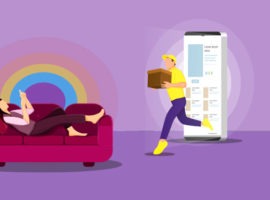E-commerce trends 2023: 15 stats + aspects shaping online shopping
 E-commerce trends in 2023 reflect an always-connected society. See the top 15 trends and stats driving the future of commerce.
E-commerce trends in 2023 reflect an always-connected society. See the top 15 trends and stats driving the future of commerce.
Consumers today expect more than just a product or service – they expect a first-rate experience too. With brands always innovating and diversifying, it may seem hard to stand out. How do you connect with customers and become their favorite?
The key is to remember that customers are human beings with needs, wants and feelings; engaging with them on a human level is vital. People remember how you made them feel, and value your band respectively.
With consumers facing a cost-of-living crisis, brands must go beyond selling and provide the experiences that will make every purchase count.
 E-commerce trends in 2023 reflect an always-connected society. See the top 15 trends and stats driving the future of commerce.
E-commerce trends in 2023 reflect an always-connected society. See the top 15 trends and stats driving the future of commerce.
E-commerce allows brands to be closer than ever to their end consumers. Brands that need frequent replenishing have realized they’re best placed to create subscription services, so customers are never without their favorite products. From beauty, to clothes, and food, the subscription market continues to grow.
Interestingly, McKinsey research states 35% of consumers who are partial to a subscription box have three or more active subscriptions making this an attractive market.
 Subscription commerce surged during the pandemic and shows no signs of slowing down. Learn why it's booming, and everything else you need to know about this business model.
Subscription commerce surged during the pandemic and shows no signs of slowing down. Learn why it's booming, and everything else you need to know about this business model.
Connecting with customers is about selling a lifestyle and an experience. Luxury brands have excelled at this. When shopping for luxury goods you expect that extra level of service, whether it’s a glass of champagne in store or a personal shopping experience online. But this kind of experience doesn’t need to stop at luxury.
Nike sets the experience bar high with its community membership – customers are invited to exclusive online previews, intimate in-person fitness events, or even simply perks like free delivery.
The North Face is another retailer which has turned what is effectively a points-based loyalty program into a lifestyle – it’s XPLR Pass offers free delivery, early access to products and member events such as unique experiences with brand ambassadors, as well as an opportunity to ‘field-test’ products before making a purchase commitment and providing feedback which creates an emotional tie with the brand.
Lululemon seems to be taking a page out of Nike’s membership strategy and last month announced a paid membership club offering fitness classes and early product access. That’s right, shoppers are paying to be part of the Lululemon brand.
By marketing your product into a lifestyle, it means that when the time comes to invest in purchases, your brand stays top of mind as customers want to be part of the culture they’ve invested their emotions in.
Marry this with a slick user journey or an exciting physical experience and you’ll stand out from the crowd.
 Personalized retail experiences drive customer loyalty, brand engagement, and the bottom line. See what brands are getting it right.
Personalized retail experiences drive customer loyalty, brand engagement, and the bottom line. See what brands are getting it right.
How do you stay relevant as a B2B business? To connect better with customers, B2B brands are increasingly moving into the direct-to-consumer space.
For example, INEOS group, a multinational chemicals company, diversified their business by launching a cycling lifestyle brand, including sponsorship of the INEOS Grenadiers cycling team, and a state-of-the-art 4×4 vehicle.
This is a prime example of a business recognizing the strength of its brand, building on the safety and security that comes with a B2B background, and diversifying its business model to attract new customers.
Similarly, you only have to glance at brand behemoth Unilever, to see the value in D2C. Unilever historically sold wholesale to supermarkets and the like, but recognizes the need to build up individual brands to create tribes of consumers for each product via social media and dedicated websites.
With Forester predicting B2B e-commerce will reach $1.8 trillion and account for 17% of all B2B sales by 2023 in the US alone, it’s clear D2C will be integral for B2B brands moving forward.
 The D2C business model is all the rage, but success isn't guaranteed. CPG brands need careful planning and a strong value prop to reap D2C benefits.
The D2C business model is all the rage, but success isn't guaranteed. CPG brands need careful planning and a strong value prop to reap D2C benefits.
Collecting consumer data and using this to build relationships and connect with customers is key in today’s digital market, and prioritizing customer experience along the entire user journey, is vital.
The consumer industry is forever changing and standing out in a world that never stands still can seem hard. Companies that make savvy use of modern technology can make agile changes and thrive, even in the toughest of times.